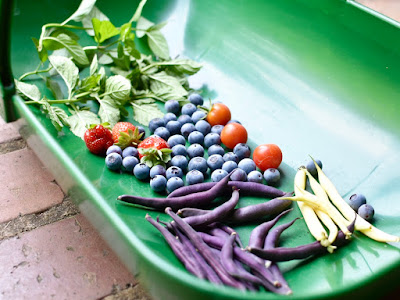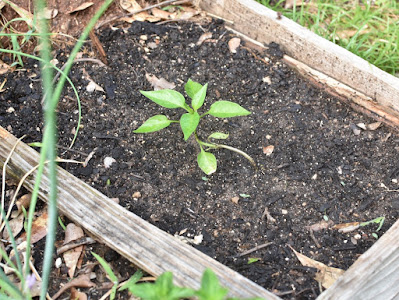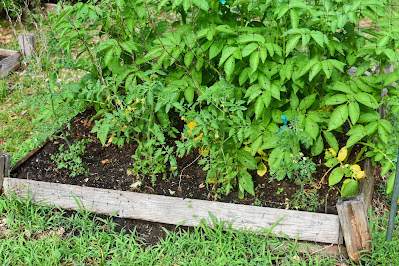 |
| My harvest last weekend: mint, blueberries, strawberries, cherry tomatoes, and beans |
It's been a pretty good year so far, in spite of the critters. Voles killed a third of my bean plants by eating the roots. Deer ate all the leaves off the remaining bean plants last month. But the bean plants bounced back somewhat and still gave me a few beans. It's really only enough for one person for one dinner, but hey, at least they look pretty. (I grew purple beans and yellow beans this year.)
 |
| My harvest this weekend: beans, cherry tomatoes, blueberries, and a Shishito pepper |
Our fence is only five feet tall, so the deer could jump over it if they really wanted to. Our deer are too lazy for that, though. After I made sure the gate stayed closed, they didn't touch the beans again. They did, however, strip the leaves off of the jalapeno plants in a pot right behind the house. Originally I started planting a couple of peppers near the house (where it's a little shadier) in case the deer got the peppers up by the vegetable garden. The deer generally don't get that close to our house. Since we got the fence, though, I guess I should just keep all of them behind the fence.
 |
| The cardinal eating blueberries on my patio |
I also have to share my harvest with the winged critters. This one cardinal, in particular, thinks he owns everything around my patio. One day I was sitting in my living room and noticed him looking at the me from an evergreen branch outside our window. I saw him jump down, so I walked to the window to get a closer look at what he was doing. Sure enough, he had flown over to one of my small blueberry bushes. He paused and stared at me. I banged on the window to try to scare him off. He just stared back brazenly as he took his blueberry, and then left. I even saw him sharing a bush with his girlfriend one day.
I've started going out every couple of days to pick the ripe blueberries, and it turns out there's still plenty of berries left for me.
While blueberries and beans are at their peak right now, a couple of other vegetables are just becoming ready to pick for the first time.
I picked the most perfect looking 'Cherokee Purple' tomato today. I love the flavor of this heirloom tomato. It's not particularly sweet, but the flavor is rich and deep, so unlike a grocery store tomato. I picked it just a tad underripe--with a little bit of that reddish/purplish color coming in. If I let it go until it's fully ripe, it usually starts getting rot or bugs digging into it. I'll leave it on a windowsill to ripen, and it should be perfect in a day or two.
I also have a new variety I'm growing this year. I planted Shishito peppers from seed early in the year, and now they are big, lush plants. I picked the first one this weekend, but there are a couple more that should be large enough to pick in a few days--and several babies coming behind them! I am quite pleased with how they've turned out. Shishito peppers are delicious sauteed or roasted, but still not common in grocery stores. We've only been able to find them when we are visiting Whole Foods in larger cities. I was afraid they would be hard to grow or whither under our heat. Instead, they seem as easy to grow as jalapenos. I think they will end up being a staple in my garden every year!
You know what I haven't mentioned yet? Zucchini. I'm just not sure I wake up early enough to grow zucchini. I've had a few female flowers from my one plant, but they always just end up withering on the vine. It's a pretty sure indication that they aren't getting fertilized, but by the time I wake up and wander outside, the flowers are all closed up. Also, I'm pretty sure the voles are tunneling in my zucchini roots--the plant went from thriving to wilting every afternoon, with a tell-tale hole right beside it. The odds are not in my favor for harvesting zucchini this year.
Vegetables aren't the only things I planted this year! Here's a shot of the coneflower I added to my flower beds this spring. It's finally getting established.
 |
| 'PowWow Wild Berry' coneflower with roses |




















































